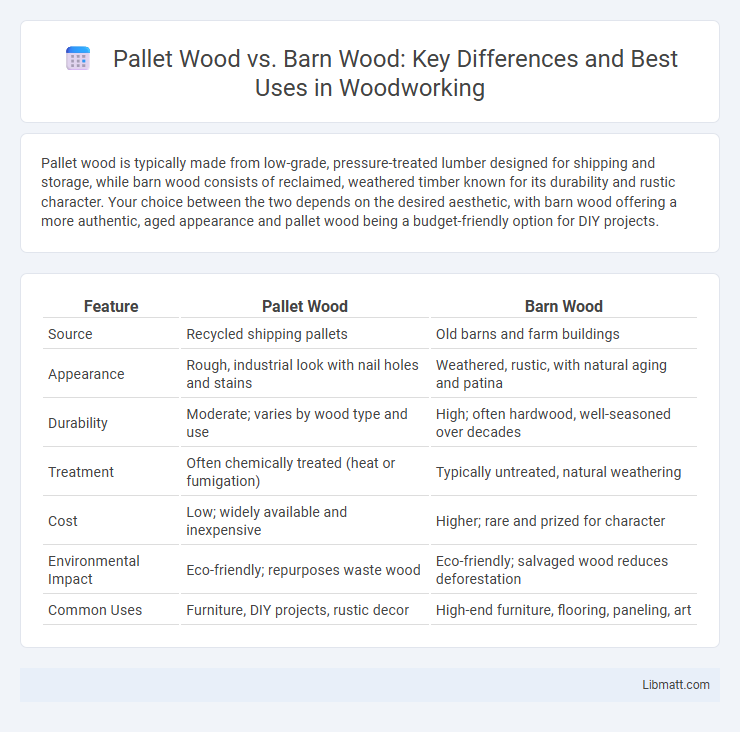Pallet wood is typically made from low-grade, pressure-treated lumber designed for shipping and storage, while barn wood consists of reclaimed, weathered timber known for its durability and rustic character. Your choice between the two depends on the desired aesthetic, with barn wood offering a more authentic, aged appearance and pallet wood being a budget-friendly option for DIY projects.
Table of Comparison
| Feature | Pallet Wood | Barn Wood |
|---|---|---|
| Source | Recycled shipping pallets | Old barns and farm buildings |
| Appearance | Rough, industrial look with nail holes and stains | Weathered, rustic, with natural aging and patina |
| Durability | Moderate; varies by wood type and use | High; often hardwood, well-seasoned over decades |
| Treatment | Often chemically treated (heat or fumigation) | Typically untreated, natural weathering |
| Cost | Low; widely available and inexpensive | Higher; rare and prized for character |
| Environmental Impact | Eco-friendly; repurposes waste wood | Eco-friendly; salvaged wood reduces deforestation |
| Common Uses | Furniture, DIY projects, rustic decor | High-end furniture, flooring, paneling, art |
Introduction to Pallet Wood and Barn Wood
Pallet wood originates from repurposed shipping pallets commonly made of softwoods like pine or spruce, valued for its affordability and rustic appearance. Barn wood consists of aged, weathered lumber from old barns, typically hardwoods such as oak or chestnut, prized for its durability and unique patina developed over decades. Both materials are popular in woodworking and interior design for their eco-friendly qualities and distinctive aesthetic characteristics.
Sourcing and Availability
Pallet wood is widely sourced from shipping and transportation industries, offering high availability due to the constant movement of goods globally, making it a cost-effective option for various projects. Barn wood, on the other hand, is reclaimed from old barns and historic structures, resulting in limited availability and often higher costs due to its unique weathered appearance and scarcity. Your choice between pallet wood and barn wood will depend on how easily you can access these materials locally and the specific aesthetic or durability requirements of your project.
Environmental Impact and Sustainability
Pallet wood is often repurposed from shipping materials, reducing waste and promoting recycling, making it a sustainable option for eco-conscious projects. Barn wood comes from old structures, offering reclaimed material that preserves historical value while minimizing the need for new lumber harvesting. Your choice between pallet wood and barn wood can significantly influence the environmental impact of your project, with both options supporting sustainable practices through reuse and conservation.
Aesthetic Differences
Pallet wood features a more uniform, industrial appearance with visible nail holes, splinters, and rough textures that reflect its functional origin. Barn wood showcases weathered, naturally aged patinas, including variations in color and grain that evoke rustic charm and historical character. The aesthetic appeal of barn wood lies in its authentic imperfections and organic wear, contrasting with the utilitarian look of pallet wood.
Durability and Strength
Pallet wood is often made from softwoods like pine, which provide moderate durability and strength but may be prone to wear and damage over time. Barn wood, typically salvaged from aged hardwoods such as oak or chestnut, offers superior durability and strength due to its dense grain and long-term weather exposure. When choosing between the two, your project's need for resilience and longevity should guide whether to prioritize the robust character of barn wood or the cost-effective versatility of pallet wood.
Cost Comparison
Pallet wood is generally more affordable than barn wood due to its widespread availability and lower-grade quality. Barn wood often commands a higher price because of its aged, weathered appearance and durability, making it a sought-after material for premium projects. If your budget is tight, pallet wood offers a cost-effective option without compromising on rustic charm.
Preparation and Treatment Requirements
Pallet wood requires thorough cleaning, sanding, and potential chemical treatment to remove contaminants and ensure safety for indoor use. Barn wood typically undergoes natural aging and drying, but still benefits from de-nailing, surface smoothing, and application of protective finishes to enhance durability. Both materials demand careful preparation to prevent pests and improve structural integrity, with pallet wood often needing more intensive treatment due to its industrial use.
Common Uses and Applications
Pallet wood is frequently used for crafting furniture, shelving, and DIY home decor due to its affordability and availability, often sourced from shipping pallets and crates. Barn wood, prized for its weathered texture and historical character, is commonly applied in flooring, paneling, and rustic interior design elements such as accent walls and beams. Both materials are favored in sustainable building and upcycling projects, but barn wood's aged patina makes it particularly sought after for preserving farmhouse and vintage aesthetics.
Pros and Cons of Pallet Wood
Pallet wood is a cost-effective and readily available material often used in DIY projects, offering a rustic aesthetic similar to barn wood but at a lower price point. Its pros include affordability, eco-friendliness through recycling, and versatility for furniture and decor; however, cons involve potential chemical contamination, inconsistent quality, and the need for thorough cleaning and treatment. Compared to barn wood, pallet wood may require more preparation to ensure safety and durability, making it less ideal for structural applications but suitable for creative, budget-friendly designs.
Pros and Cons of Barn Wood
Barn wood, prized for its rich patina and durability, offers a unique aesthetic that enhances rustic and vintage designs. Its natural weathering and historic character provide strength and charm but can include nails, dirt, and potential insect damage requiring careful cleaning and treatment. While barn wood is often more expensive and less uniform than pallet wood, its superior quality and authenticity make it a preferred choice for high-end furniture and architectural projects.
Pallet wood vs barn wood Infographic

 libmatt.com
libmatt.com